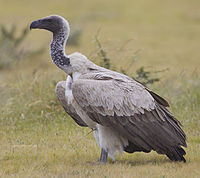
Photo from wikipedia
Diclofenac, a non-steroidal anti-inflammatory drug (NSAID) was responsible for the death of millions of vultures on the Asian subcontinent, following the consumption of diclofenac contaminated carcasses. The aim of this… Click to show full abstract
Diclofenac, a non-steroidal anti-inflammatory drug (NSAID) was responsible for the death of millions of vultures on the Asian subcontinent, following the consumption of diclofenac contaminated carcasses. The aim of this research was to establish if liver slices could serve as an alternate means of predicting the toxicity of NSAIDs in Gyps vultures. The Cape vulture liver slices was prepared and incubated with four NSAIDs for 6 h. A percent clearance of 1.0 ± 0.253, 0.58 ± 0.153, 0.961 ± 0.312 and 1.242 ± 0.406 (%/h*g) was attained for diclofenac, carprofen, ketoprofen and meloxicam respectively. Both meloxicam and diclofenac exerted toxic effects on the hepatic cells. Protein content indicated that the vulture tissue had lower enzyme levels than expected for an animal of its size. The poor distinction between the ex vivo hepatic percent clearance of meloxicam and diclofenac indicates that liver slices is not an ideal model to investigate NSAIDs toxicity in Cape vulture.
Journal Title: Environmental toxicology and pharmacology
Year Published: 2018
Link to full text (if available)
Share on Social Media: Sign Up to like & get
recommendations!